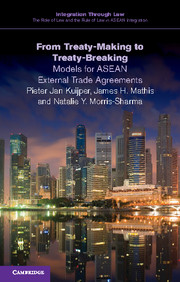Book contents
- Frontmatter
- Contents
- General editors' preface
- List of abbreviations
- 1 Introduction
- 2 Substantive components of an ASEAN trade agreement from an external perspective
- 3 Moving forward: different institutional models for ASEAN's external trade agreements
- 4 The rules on dispute settlement in agreements between ASEAN member states and third states: a critical inventory
- 5 From treaty-making to treaty-breaking
- Executive summary
- Appendix 1 Agreements signed by ASEAN member states with a non-ASEAN party
- Appendix 2 ‘Non-ASEAN’ agreements
- References
- Index
Executive summary
Published online by Cambridge University Press: 05 April 2015
- Frontmatter
- Contents
- General editors' preface
- List of abbreviations
- 1 Introduction
- 2 Substantive components of an ASEAN trade agreement from an external perspective
- 3 Moving forward: different institutional models for ASEAN's external trade agreements
- 4 The rules on dispute settlement in agreements between ASEAN member states and third states: a critical inventory
- 5 From treaty-making to treaty-breaking
- Executive summary
- Appendix 1 Agreements signed by ASEAN member states with a non-ASEAN party
- Appendix 2 ‘Non-ASEAN’ agreements
- References
- Index
Summary
This study demonstrates the different methods by which the Association of Southeast Asian Nations (ASEAN) and its member states can conclude trade agreements with non-member states. It then considers the implications of these different forms for the substantive provisions that may likely be contained in future trade agreements and the mechanisms that may be used in them for resolving disputes among the signatories. These elements are covered through all of the aspects of the treaty process, from ‘treaty-making’ through ‘treaty-implementation’ and to ‘treaty-breaking’.
There are three general methods (or forms) that we know from the law and practice of ASEAN and other international organisations that appear to be open to ASEAN and its members. They are made possible by the powers granted to ASEAN by its member states by the various treaties that form the foundation of the organisation. These explicitly include the power to conclude international agreements, but without being very precise as to how the organisation should exercise this treaty-making power.
The first form is that an external agreement can be concluded by all or some of the member states of ASEAN on behalf of themselves, as individual states or as a collective embodiment ‘in the name of’ the organisation. The second form, and at the other end of this spectrum, is when ASEAN as an organisation is the only stated party on its side of an agreement. Thirdly, and somewhere in the middle of this spectrum, there is the possibility of what has been called in EU law, a ‘mixed agreement’, that is to say, that ASEAN and its member states together can conclude an agreement on the side of ASEAN. As we will see, the first and third methods have many variations.
In order to better understand the three methods of treaty-making as they might apply to ASEAN and its member states, we study both the founding instruments of ASEAN and their development over the years, and also delve into the practice of ASEAN and its member states in concluding international agreements.
- Type
- Chapter
- Information
- From Treaty-Making to Treaty-BreakingModels for ASEAN External Trade Agreements, pp. 216 - 223Publisher: Cambridge University PressPrint publication year: 2015



